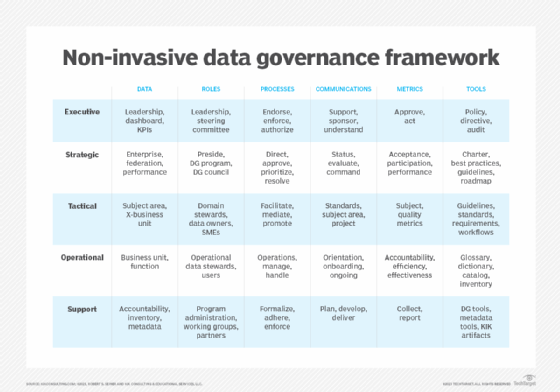Noninvasive data governance offers friendly approach
Data governance doesn't need to be a burden on employees. A noninvasive approach formalizes existing responsibilities as components of a governance program.
No organization can successfully use data without a solid data governance program. The responsibility of governance falls on many shoulders. Robert Seiner came up with a noninvasive approach to present governance duties in an accessible manner.
People often think governance is difficult and time-consuming because they need to manage it. Employees may feel they have additional duties added to an already full plate, which creates tension and resistance. Seiner attests that his approach is less invasive because it formalizes governance responsibilities as tasks that are already in place, but in an informal or inefficient manner.
"People are defining, producing and using data as part of their job," Seiner writes in Non-Invasive Data Governance Strikes Again: Gaining Experience and Perspective. "If we hold these people formally accountable for their actions, they are stewards of the data. Non-Invasive Data Governance will assist you with moving from informal to formal accountability."
Seiner opens the book sharing his experience and perspectives on data governance. He details his example of a noninvasive data governance framework and how it differs from the two common data governance approaches: command-and-control and traditional.
Traditional governance puts the responsibility on management to get employees on board and using governance tools and programs. Traditional governance identifies who should have governance roles and they should fit responsibilities into existing workflows.
Command-and-control governance is a top-down model where leadership assigns governance responsibilities to existing positions. Employees can feel it's adding work to their duties.
Noninvasive governance presents governance responsibilities as job duties that employees are already doing. Recognizing governance responsibilities as part of existing work helps define the importance of governance policies and avoids employee overload.
"Rather than making the discipline appear threatening and difficult, I suggest following a Non-Invasive Data Governance approach to formalize what already exists and address opportunities to improve," Seiner writes.

Throughout the book, Seiner discusses the necessary supporting elements for a noninvasive data governance strategy, key organizational roles and design, how to demonstrate the business value of governance, the importance of behavior in successful governance and the required technology.
This is Seiner's second book about noninvasive data governance. His first book, Non-Invasive Data Governance: The Path of Least Resistance and Greatest Success, was published in 2014. A key element of Seiner's insights in his second book is sharing the lessons and perspectives he's learned during a decade of working with organizations to implement noninvasive data governance. Check out an excerpt from Chapter 1. Visit the Technics Publications page to learn more or purchase the book.
Peter Spotts is the site editor for SearchBusinessAnalytics and SearchDataManagement, writing and managing content on both sites. Prior to joining TechTarget in July 2021, Peter worked for Turley Publications in Palmer, Mass., as both a staff writer and editor covering local events and news for six years in Western Mass.






